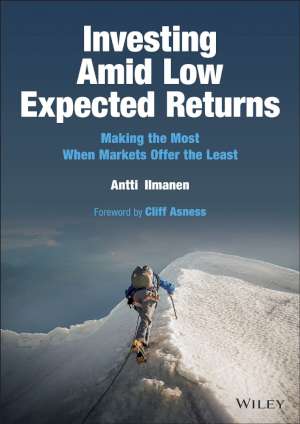24 November 2022
Investing Amid Low Expected Returns
Antti Ilmanen
2022, Wiley, 304 pages,
ISBN 9781119860198
Reviewer: Kate Barker, British Coal Staff Superannuation Scheme

The title of this book is obvious catnip for me as the chair of two large pension funds – I turned to it with high hopes for helpful insights. The author works for AQR where he advises many funds and here he draws not just on his own long experience but also a wealth of academic literature. It offers a rich source for those seeking historic evidence to support or undermine various investment theories or beliefs.
The first of three parts describes the present investment background. It starts with a rather brief argument for the thesis that the next decade will see low realised returns – based on the view that (at least at the time of writing in 2021) low asset yields and strong asset prices have brought returns forward, and that growth prospects are weak. (Although as Ilmanen remarks – this is merely an opinion). In this situation investors need to be ‘serene’ - which means accepting this situation and not striving too hard. Equally the recent years of good returns may have fostered complacency. There is a good description of some of the major investor types and the recent history of how they have invested. It includes the point that pension fund equity selling has to some extent been matched by endowment equity acquisition.
The second part is an excellent set of chapters on the evidence for and against different ways of achieving long-term returns. There are many interesting observations and a wealth of academic references. Below are a few of his comments which I found interesting – though in some cases they simply confirmed my prior prejudices:
In the long-term, a diversified basket of commodities has earned 3-4% above cash.
Domestic GDP growth is not always well correlated with domestic equity returns.
Be cautious about the prospect of an illiquidity premia obtained from private equity – not all can create alpha.
A careful analysis of housing versus equities over a long period concludes that housing is unlikely to be a better bet.
There is empirical support for momentum strategies, carry and also for defensive. Low beta stocks seem to offer higher risk-adjusted returns. Value strategies used to be supported, but have recently lost out. This may cast doubt on the longevity of any strategy.
It isn’t easy to find alpha – not least as it is uncertain how to risk-adjust outcomes to be sure alpha was really there.
It is hard to explain any long-run good return sources. And if there is such a return – who is on the other side and losing money?
Past data gives strong support for the value of patience – but this can be very hard to maintain.
The third part considers the various techniques the author would recommend to improve returns. Some can be carried too far – so in arguing for diversification he points out that full exploitation requires leverage which (as we just found in some UK pensions funds) can bring other risks. Similarly, liquidity issues can constrain the adoption of mean-variance optimisation. Risk management needs to be done at the portfolio level, and be robust across scenarios. Investors should be open to use of equity tail risk hedges – though here pricing is crucial. On ESG Ilmanen is rather agnostic in terms of long-term investment success – though suggesting that a focus on governance factors has recently paid off. In assessing managers and ideas investors need to take time and prefer statistics to stories. Lastly common investment bad habits are identified: such as impatience and over-extrapolation.
The final chapter contains what has turned out to be a highly prescient quote: ‘We still have near record rich equities, low bond yields, extreme value-growth spread, and so on, all of which make historical average returns biased, and major corrections soon could make the book appear quickly dated. Well, I should serenely accept I cannot alter this.’
Given that, did it offer me the fresh thinking I was seeking? An overarching conclusion was that good investment practices remain much the same through all economic environments – important in itself but not quite true to the book’s title. Indeed Ilmanen stresses that the low return prospect should not mean taking much more, or less, risk than before – rather one should concentrate on efficient investment. The list of these good practices, as set out on the penultimate page, would be good pinned up in trustee meetings – they are not unfamiliar but could be easily forgotten. The investment problems of a particular institution however tend to be idiosyncratic – some of the recommendations here would not be useful to the real-life problems particular funds have. But there is certainly food for thought and a few cherished investment beliefs are shown to have weak empirical foundations.
